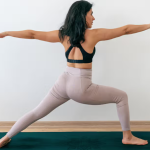According to B.K.S. Iyengar there are four stages to yoga: commencement, intent endeavour, intimate knowledge and consummation. Following from my article ‘5 Good Reasons To Start Yoga‘ from last week, I’m going to assume that we can tick the ‘commencement’ box — and that’s a big tick as it’s very true that the hardest step of any journey is the first. Next on the list is ‘intent endeavour’, which means that once we’ve started our Yoga journey we have to:
- Make sure we keep going, and
- Focus on how we can keep motivated
Why Do We Stop Doing Yoga In The First Place?
We all start out with good intentions, but it’s much harder to translate those intentions into action, especially when many of us have so many pulls on our time and energy. Maybe you started yoga a while ago, and then life and work got too busy. Maybe, like me, you did antenatal yoga and loved it, but when the kids came along you felt you couldn’t justify going off to do something as self-indulgent as a yoga class.
In fact, the sage Patañjali lists nine obstacles to yoga: sickness, languor, doubt, indifference, laziness, uncontrolled desire, lack of concentration and instability after long practice. That list doesn’t even include, ‘desire to socialise’ or ‘inability to keep eyes open due to lack of sleep’. Basically, there are a lot of hurdles to jump before we even get onto the mat.
So, to give you a boost, I’d like to give you some reasons for staying on the path or re-finding it, because it’s always there waiting for you.
1. Be Inspired By Your Teacher
The ancient tradition of yoga has been repackaged for the way we live today, but the way we learn yoga hasn’t changed. You go to a class to learn from a teacher. That teacher will be more experienced, will see things that you do not, and will know the way your body works. As Iyengar says:
The obstacles, trials and tribulations in the path of yoga can be removed to a large extent with the help of a Guru.
Unlike other forms of exercise, like running or body building, your teacher will guide and correct you. A good teacher will encourage you and push you when you start to flag. Use this tool and use their wisdom and energy. That’s what they’re there for, and they love their job!
2. Focus On The Needs Of Your Body
Once you’ve taken your first steps into yoga you start to get to know your body a bit more; like Rob has been experiencing so far, with his knees up round his ears, you’ll have become aware of your strengths and weaknesses. You’ll also have started to work out which poses you feel more comfortable doing, and which ones make you feel like running a mile. You’re starting to form a yogic relationship with your body.
By practicing the sequences of poses, our bodies are gradually extended and strengthened. The more we do the poses, the quicker the transformation. Whether you go once a week, or have established a daily practice, any time spent on the mat is time well spent on your body.
3. Give Up Results
In work, as in life, we have become ‘goal-driven’. We are constantly looking forwards, making lists, aiming to achieve our dreams. This is all well and good, but sometimes this preoccupation takes us time travelling so far into the future we forget about the present. When we are in a class, wobbling in Warrior 1 (Vῑrabhadrāsana I), we have to be in the moment, in the now, be it pressing down the big toe mound, or straightening the back leg. Without this concentration we will flail and fall.
The results of yoga are tangible and real, but just because we can’t sit on the floor in Seated Hero Pose (Vῑrāsana) or get that other foot up in Lotus Pose (Padmāsana) it doesn’t mean we’re failing. Every effort and every inhabited pose is a result, pushing us into a deeper understanding of the present moment.
4. “How Do You Do, Me?”
The previous two reasons have touched on this one, but it’s worth stating that yoga is as much about the mind as the body. Some poses — such as back bends — work on opening up the chest, and this unfamiliar movement can leave you feeling vulnerable. By opening up the body, we open up the mind to things that sometimes we’d rather leave hidden, which can be an uncomfortable experience. Many beginners find that this can manifest itself through tears or giggles.
In his book, Light on Prānayāma, Iyengar says that the hardest pose can often be Savāsana. The frantic mind is forced to be still, which for the doers among us can feel excruciating. That little itch on our nose becomes a torture as the mind fights to keep up a constant chatter. When we allow that jumping bean of a mind to fall still, even for the smallest moment, we open a chink in the door to eternity.
5. Finding Joy
The eighth limb of Yoga is ‘samādhi’ or ‘superconsciousness’. Only the most devoted yogis reach this state in its purest form, but a glimpse of it is available to the humblest and stiffest of practitioners at any point. When do you last remember experiencing joy? It tends to be when we give in to the moment, and that burden of care or stress that we didn’t even know we were carrying drops away, leaving us feeling light and open.
If we can use yoga poses to come into the present moment, fully inhabiting our body, we open ourselves up to the feeling of joy. B.K.S. Iyengar sums it up best when he says:
In some postures, we lose the sense of duality and we live in peace, in a joy we cannot express in words. And even if we have to fight all our life to find this joy once more, it is worth doing it.
We’re ALL In It Together
No one, not even the greatest of yoga practitioners, is perfect. My teacher trainer was telling me that even Mr. Iyengar himself said that he could remember that for a whole year in 1956 his practice was ‘stagnant’! Don’t be discouraged or downhearted. Keep positive and remember that everyone is learning together.
Let us know if you’ve ever let your yoga practice slip, and what you’ve done to restart your practice. Do you have any tips and techniques to be consistent on your mat? How do you practice self-compassion if you don’t reach your goals? Comments are below!













